- Home
- Lynne Olson
Those Angry Days: Roosevelt, Lindbergh, and America's Fight Over World War II, 1939-1941
Those Angry Days: Roosevelt, Lindbergh, and America's Fight Over World War II, 1939-1941 Read online
Copyright © 2013 by Lynne Olson
All rights reserved.
Published in the United States by Random House,
an imprint of The Random House Publishing Group,
a division of Random House, Inc., New York.
RANDOM HOUSE and colophon are registered trademarks of Random House, Inc.
Grateful acknowledgment is made to Houghton Mifflin Harcourt for permission to reprint excerpts from The Wartime Journals of Charles A. Lindbergh by Charles A. Lindbergh, copyright © 1970 by Charles A. Lindbergh and renewed 1998 by Anne Morrow Lindbergh and Reeve Lindbergh, and excerpts from War Within and Without: Diaries and Letters of Anne Morrow Lindbergh, 1939–1944 by Anne Morrow Lindbergh, copyright © 1980 by Anne Morrow Lindbergh. Reprinted by permission of Houghton Mifflin Harcourt. All rights reserved.
PHOTO CREDITS: All images are from the Library of Congress with the exception of this page and this page, which are from Manuscripts and Archives, Yale University Library, and this page, which is reprinted courtesy of Century Association Archives Foundation.
LIBRARY OF CONGRESS CATALOGING-IN-PUBLICATION DATA
Olson, Lynne.
Those angry days: Roosevelt, Lindbergh, and America’s fight over World War II, 1939–1941 / by Lynne Olson.
p. cm.
Includes bibliographical references.
eISBN: 978-0-679-60471-6
1. World War, 1939–1945—United States. 2. World War, 1939–1945—Diplomatic history. 3. Roosevelt, Franklin D. (Franklin Delano), 1882–1945—Political and social views. 4. Lindbergh, Charles A. (Charles Augustus), 1902–1974—Political and social views. 5. Isolationism—United States—History—20th century. 6. Intervention (International law)—History—20th century. 7. United States—Politics and government—1933–1945. 8. Political culture—United States—History—20th century. 9. United States—Foreign relations—1933–1945. 10. United States—Military policy. I. Title.
D753.O47 2013
940.53′10973—dc23 2012025381
www.atrandom.com
Jacket design: Michael Boland for The Boland Design Company
Jacket images: The New York Public Library/Art Resource, N.Y. (Charles Lindbergh), © Bettmann/Corbis (Franklin D. Roosevelt), Herbert Mason/Daily Mail/Getty Images (St. Paul’s Cathedral)
v3.1
Though historians have dealt with the policy issues, justice has not been done to the searing personal impact of those angry days.
—ARTHUR M. SCHLESINGER JR.
In a democracy, a politician is supposed to keep his ear to the ground. He is also supposed to look after the national welfare and to attempt to educate the people when, in his opinion, they are off base.
—JOHN F. KENNEDY
You can always count on Americans to do the right thing—after they’ve tried everything else.
—WINSTON CHURCHILL
CONTENTS
Cover
Title Page
Copyright
Epigraph
INTRODUCTION
1. “A MODERN GALAHAD”
2. “WE WERE FOOLS”
3. “WHERE IS MY WORLD?”
4. “YOU HAVEN’T GOT THE VOTES”
5. “THIS WAR HAS COME HOME TO ME”
6. “I AM ALMOST LITERALLY WALKING ON EGGS”
7. “PARANOIA CAN BE CATCHING”
8. “THE ART OF MANIPULATION”
9. “IS THIS WAR OUR CONCERN?”
10. “WHY DO WE NOT DEFEND HER?”
11. “THE GREATEST OF ALL OUR AMBASSADORS”
12. “THE PEOPLE SAVED THE DAY”
13. “CONGRESS IS GOING TO RAISE HELL”
14. “AN AMERICAN FIRST, AND A REPUBLICAN AFTERWARD”
15. “THE YANKS ARE NOT COMING”
16. “THE BUBONIC PLAGUE AMONG WRITERS”
17. “A NATIONAL DISGRACE”
18. “WELL, BOYS, BRITAIN’S BROKE”
19. “A RACE AGAINST TIME”
20. “A TRAITOROUS POINT OF VIEW”
21. “DER FÜHRER THANKS YOU FOR YOUR LOYALTY”
22. “WHERE IS THIS CRISIS?”
23. “PROPAGANDA … WITH A VERY THICK COATING OF SUGAR”
24. “SETTING THE GROUND FOR ANTI-SEMITISM”
25. “HE WAS NOT GOING TO LEAD THE COUNTRY INTO WAR”
26. “THE GREATEST SCOOP IN HISTORY”
27. “LET’S LICK HELL OUT OF THEM”
28. AFTERMATH
Dedication
ACKNOWLEDGMENTS
NOTES
BIBLIOGRAPHY
Other Books by This Author
About the Author
INTRODUCTION
On a soft April morning in 1939, Charles Lindbergh was summoned to the White House to meet President Franklin D. Roosevelt, arguably the only person in America who equaled him in fame. The images of the two men had been indelibly impressed on the nation’s consciousness for years—Lindbergh, whose solo flight across the Atlantic in 1927 had mesmerized and inspired his countrymen, and Roosevelt, whose energetic, confident leadership had helped jolt a Depression-mired America back to life.
When Lindbergh was ushered into the Oval Office, he found FDR seated behind his desk. It was their first face-to-face encounter, but no one would have guessed that from the president’s warm, familiar manner. Leaning forward to clasp Lindbergh’s hand, Roosevelt welcomed him as if he were an old friend, asking him about his wife, Anne, who, the president noted, had been a high school classmate of FDR’s daughter, Anna.
His head thrown back, with his trademark cigarette holder tilted rakishly upward, Roosevelt exuded charm, joie de vivre, and an unmistakable air of power and command. During his thirty-minute chat with Lindbergh, he gave no sign of the many grave problems weighing on his mind.
He was, in fact, in the midst of one of the greatest crises of his presidency. Europe was on the brink of war. The month before, Adolf Hitler had seized all of Czechoslovakia, violating the promise he had made at the 1938 Munich conference to cease his aggression against other countries. In response, Britain and France had promised to come to the aid of Poland, the next country on Germany’s hit list, if it were invaded. Both Western nations, however, were desperately short of arms, a situation that FDR was trying to remedy. But he was faced with a dilemma. Thanks to the provisions of neutrality legislation passed by Congress a few years earlier, Britain and France would be barred from buying U.S. weapons once they declared war on Germany. As Roosevelt knew, his chances of persuading the House and Senate to repeal the arms ban were close to zero.
But he mentioned none of that in his conversation with Lindbergh. Nor, in the course of his genial banter, did he betray any hint of the considerable suspicion and distrust he felt for the younger man sitting opposite him. Five years before, Roosevelt and Lindbergh had engaged in what the writer Gore Vidal called a “mano a mano duel,” in which the president emerged as the loser. FDR hated to lose, and his memories of the 1934 incident were still raw and bitter.
The clash had been prompted by Roosevelt’s cancellation of airmail delivery contracts granted by his predecessor, Herbert Hoover, to the nation’s largest airlines. Charging fraud and bribery in the contract process, Roosevelt directed the U.S. Army Air Corps to start delivering the mail. Lindbergh, who served as an adviser to one of the airlines, publicly criticized FDR for ending the contracts without giving the companies a chance to respond.
Less than seven years after his history-making flight, the thirty-two-year-old Lindbergh was the only
person who could match the fifty-two-year-old president in national popularity. They were alike in other ways, too. Both were strong-willed, stubborn men who believed deeply in their own superiority and had a sense of being endowed with a special purpose. They were determined to do things their own way, were slow to acknowledge mistakes, and did not take well to criticism. Self-absorbed and emotionally detached, they insisted on being in control at all times. A friend and distant relative of FDR’s once described him as having “a loveless quality, as if he were incapable of emotion.” Of Lindbergh, a biographer wrote: “The people he called friend were mainly, to him, good, functional, temporary acquaintances. He seemed to have taken much more than he gave in the way of warmth and affection.”
The conflict between the president and Lindbergh quickly became front-page news. A former airmail pilot himself, Lindbergh warned that Air Corps fliers had neither the experience nor the right type of instruments in their planes to take on the extremely hazardous job of delivering the mail, which often involved night flying in blizzards, heavy rain, and other extreme weather. To the administration’s embarrassment, his assessment proved correct. In the four months that Army pilots flew the mail, there were sixty-six crashes, twelve deaths, and, as one writer put it, “untold humiliation” for the Air Corps and White House. On June 1, 1934, following rushed negotiations between the government and airlines to come up with new delivery agreements, the commercial companies resumed mail delivery.
For the first time in his year-old presidency, FDR found himself bested in the court of public opinion. According to the historian Arthur M. Schlesinger Jr., “the fight dented the myth of Roosevelt’s invulnerability. It quickened the pace and intensity of criticism of the administration.… [It] also uncovered in Charles Lindbergh a man who perhaps appealed to more American hearts than anyone save Franklin Roosevelt.”
The following year, Lindbergh took his family to live in England, then France. During his three-year stay in Europe, he made several highly publicized trips to Nazi Germany, where he inspected aircraft companies and air force bases—and made clear he thought that the German air force was invincible and that Britain and France must appease Hitler.
And now he was home, ostensibly to join General Henry “Hap” Arnold, head of the Air Corps, in an effort to build up America’s own airpower as quickly as possible. But was he plotting something else? The last thing Roosevelt needed was a campaign to stir up public opposition to the idea of arms sales to Britain and France. He had invited Lindbergh to the White House to get a sense of the man, to try to figure out how much of a problem he might pose in the turbulent days to come.
During his session with Roosevelt, Lindbergh was well aware that the president was scrutinizing him closely. Writing later in his journal, he noted, “Roosevelt judges his man quickly and plays him cleverly.” Although he thought FDR “a little too suave, too pleasant, too easy,” Lindbergh still enjoyed the encounter. “There is no reason for any antagonism between us,” he observed. “The air-mail situation is past.” He would continue to work with the administration on ways to improve the nation’s air defenses, but, he added, “I have a feeling that it may not be for long.”
Photographers swarm around Charles Lindbergh as he leaves the White House after a meeting with President Roosevelt in April 1939.
He was right. In early September, just five months later, Hitler invaded Poland, and Britain and France declared war on Germany. The following spring, German troops swept through Western Europe, vanquishing France and threatening Britain’s survival. As unofficial leader and spokesman for America’s isolationist movement, Lindbergh emerged as Franklin Roosevelt’s most redoubtable adversary in what would become a brutal, no-holds-barred battle for the soul of the nation.
UNTIL MAY 1940, MOST Americans had viewed the war in Europe as if it were a movie—a drama that, while interesting to watch, had nothing to do with their own lives. But the shock of Germany’s blitzkrieg demolished that belief. It forced the country to struggle with two crucial questions: Should it come to the aid of Britain, the last hope of freedom in Europe? Or should it go even further and enter the war?
For the next eighteen months, the debate over those issues raged throughout the nation, from the White House and halls of Congress to bars, beauty parlors, offices, and classrooms in the biggest of cities and smallest of towns. “The war was everywhere,” one historian recalled. “It lay behind everything you said or did.” Millions of Americans were swept up in the struggle, knowing that whatever its outcome, their lives were likely to be profoundly affected. At stake was not only the survival of Britain but the shape and future of America.
What was the United States to be? A fortress country that refused to break out of its isolationist shell, still clinging to the belief that it could survive and thrive only if it were free from entangling foreign commitments? The adherents to that view pointed to the aftermath of World War I as proof of its validity. We had been tricked, they argued, into coming to the aid of Britain and France in 1917, thereby losing more than fifty thousand of our young men and providing our allies with loans that were never repaid. We were supposedly making the world safe for democracy, but in fact democracy had cravenly given way to Adolf Hitler. Britain, France, and the rest of Western Europe had repeatedly demonstrated an inability to settle their own disputes. If those countries refused to stop Hitler when they could have, why should we bail them out again? We must be ready to fight for the defense of our own nation, but for nothing and no one else.
For their part, those who argued for U.S. intervention maintained that America could no longer evade international responsibility: the times were too dire. Britain’s survival was absolutely essential for our security and welfare. If the British were defeated and Hitler controlled all of Europe, he would then move to dominate Africa and infiltrate South America, thus posing a serious threat to the United States. America, the interventionists argued, would have little chance to survive as a free, democratic society.
Others in the interventionist camp emphasized what they viewed as America’s moral obligation to stop Hitler—the embodiment, as they saw it, of pure evil. How could we stand on the sidelines, they argued, while Nazi Germany enslaved sovereign countries, went on a rampage against Jews, and threatened to wipe out Western civilization as we know it?
The passions engendered by the debate were as high as its stakes. The CBS correspondent Eric Sevareid remembered the period as “bitter” and “heart-burning.” Arthur Schlesinger said the dispute was “the most savage political debate in my lifetime.” He added: “There have been a number of fierce national quarrels—over communism in the later Forties, over McCarthyism in the Fifties, over Vietnam in the Sixties—but none so tore apart families and friendships as this fight.”
One of the families most deeply affected was that of Lindbergh’s wife, Anne, whose mother was an outspoken advocate for American involvement in the war and whose brother-in-law, a Welshman named Aubrey Morgan, happened to be one of the British government’s top propagandists in the United States. While Anne Morrow Lindbergh supported her husband in his isolationism, her sister, Constance Morrow Morgan, worked with her husband in New York attempting to sway American public opinion in favor of Winston Churchill and the British.
AS MOMENTOUS AS IT WAS, the passionate prewar battle over America’s destiny has largely disappeared from the national memory. “The intense feelings and bitter conflicts of the time were engulfed in the vast events which followed Pearl Harbor,” Anne Lindbergh noted decades later. “Today, hardly anyone gives much thought to what was once called ‘the Great Debate.’ ”
Certainly, little has been written that brings to life this suspenseful, tumultuous, and vital period in U.S. history, with its host of colorful, larger-than-life characters. “Though historians have dealt with the policy issues,” Arthur Schlesinger wrote, “justice has not been done to the searing personal impact of those angry days.” General George Marshall, who became Army chief of staff o
n the day Hitler invaded Poland, observed to his official biographer: “People have forgotten the great hostility of that time.”
Marshall, like many others in Washington, found himself intimately involved in the dispute. Throughout the period, the nation’s capital was a nest of intrigue and infighting. In early 1941, a harsh debate between isolationist and interventionist congressmen ended in an unseemly brawl on the floor of the House. On the lawn outside the Capitol, demonstrators threw a rope around a tree branch to hang the straw-stuffed effigy of a senator who favored aid for Britain. The wife of a Washington columnist who endorsed such aid received a package in the mail one morning. Opening it, she found a tiny black coffin containing a paper skeleton. The skeleton was labeled “Your husband.”
The upper reaches of the Roosevelt administration, including the president’s cabinet, were also riven with deep divisions about which direction the country should take. Many high-ranking officers in the Army, Navy, and Air Corps fiercely opposed FDR and his proposals to help the British. Convinced that America should stay clear of the war, a number of them worked to sabotage the policies of their commander in chief, leaking top-secret information to isolationist members of Congress and to Lindbergh and other key leaders in the antiwar movement. Just before Pearl Harbor, Hap Arnold, the Air Corps chief of staff, was implicated in the leak of one of the administration’s most closely guarded military secrets—a contingency plan for all-out war against Germany.
George Marshall would later say that he had been frequently approached during this time by subordinates who wanted him “to take open action contrary to the administration.” Marshall, who believed strongly in civilian control over the military, never did so. Nonetheless, his role in the pre–Pearl Harbor struggle was far more complex than has been commonly portrayed. Focused on transforming an emaciated U.S. army into a powerful force, the man who is widely—and rightly—regarded as the country’s greatest military figure in World War II was hostile to the idea of sharing with the British the few modern military resources America then possessed. And until late 1941, he disapproved of U.S. entry into the conflict. While Marshall himself never openly rebelled against FDR’s policies, he supported and protected those on his staff who did.

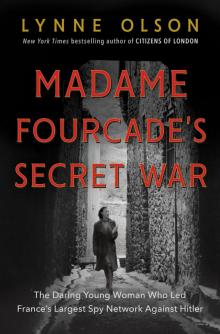 Madame Fourcade's Secret War
Madame Fourcade's Secret War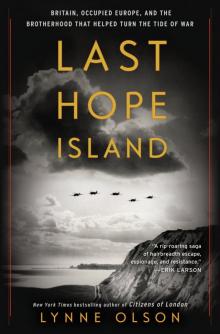 Last Hope Island
Last Hope Island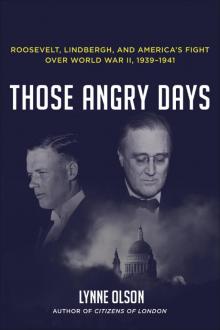 Those Angry Days
Those Angry Days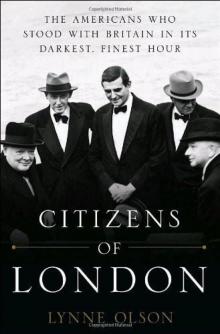 Citizens of London
Citizens of London Citizens of London: The Americans Who Stood With Britain in Its Darkest, Finest Hour
Citizens of London: The Americans Who Stood With Britain in Its Darkest, Finest Hour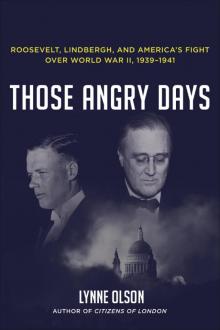 Those Angry Days: Roosevelt, Lindbergh, and America's Fight Over World War II, 1939-1941
Those Angry Days: Roosevelt, Lindbergh, and America's Fight Over World War II, 1939-1941